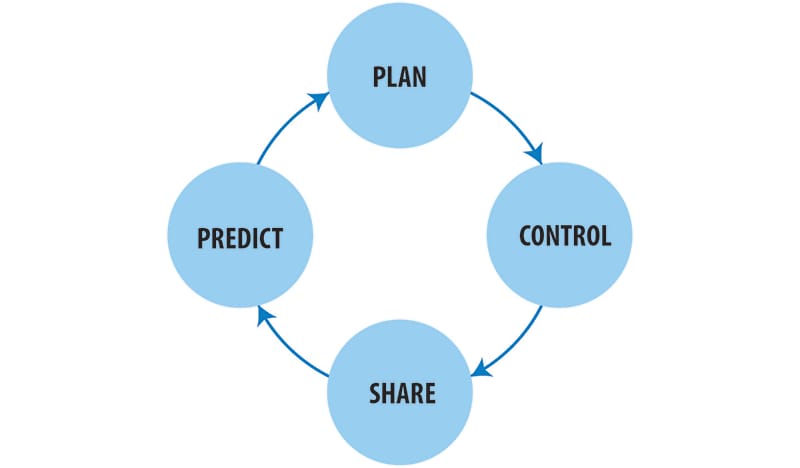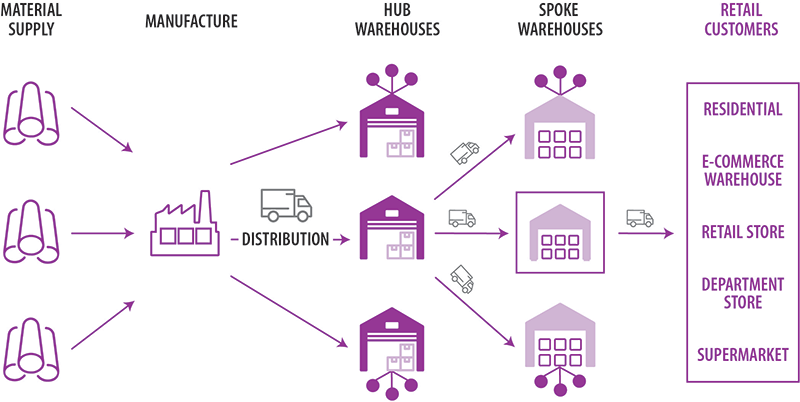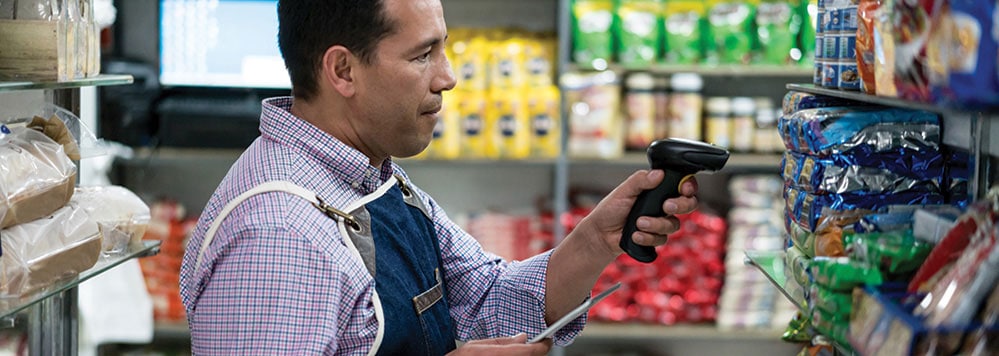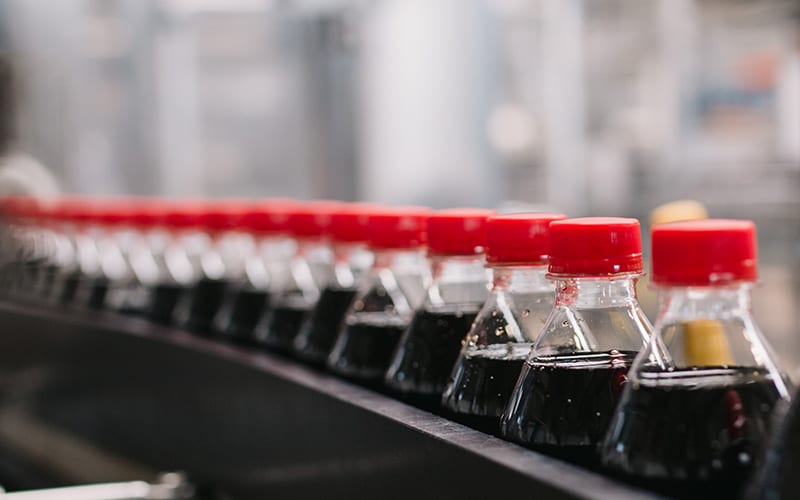Pressure to change delivery
Managing a consumer goods supply chain has become more complex than ever. CPG brands are servicing a growing range of channels, with smaller batches of products that come in a wider variety of formats, to retailers who are struggling to compete for end consumers who are ever fickler with their loyalties.
A seminal BCG report1 from 2018 highlighted the plight of supply chain managers in the first half of this decade. Their research found that on-time delivery performance fell sharply between 2010 and 2014, down by 7.5%, and only rebounded slightly in 2016.
A third of the report’s respondents cited supply chain complexity and channel proliferation as a top three concern that affects service levels and costs. Almost half cited logistics costs and customer service as perennial concerns.
The consensus across the industry was to better use available data to predict demand changes and inform supply chain partners. But the ever growing complexity and increasing demand for service at lower cost makes this difficult without significant investments in automation. The question is, where to start?
Moving too fast
The problem is consumers keep changing, fast. Increased urbanization, smaller families — or the delaying of people having families — and the interconnectedness of consumers through the internet all play a part. This has had an enormous effect on how CPG brands design their products and reach the end buyer.
Consumers now expect more convenience in the form of multiple retail formats and locations, as well as online and offline service. This leads to the proliferation of more, and smaller, stores — most of which are unable to hold significant levels of inventory, relying on more regular deliveries.
Product sizes are also falling. Products are increasingly designed for individuals rather than families. And while these can be sold at a higher margin, they also move off shelves much faster, requiring regular restocking.
The challenge for CPG suppliers is that they tend to have deals with logistics firms based on tonnage. But as smaller batches of lighter products need to be delivered to a wider variety of locations, the result is that often trucks are not being filled and money is being wasted.
In the midst of this, price wars and aggressive discounting among supermarkets and retail chains has become the norm. This means that retailers are looking to reduce their costs as much as possible. This often involves pushing inventory back onto suppliers to hold at their cost, further burdening their network and forcing them to balance inventory better geographically.
And when demand forecasting and inventory balancing don’t work effectively, it can lead to significant missed sales. Out-of-stocks resulted in almost $1 trillion in missed sales worldwide, with $145 billion of this in North America alone, according to research group IHL2.
If this was not enough, the whole industry is competing on how quickly it can design, launch and deliver new products to evermore internet savvy consumers. The rise of direct to consumer and new startup brands, as well as the increased targeting of micro-segments through digital marketing, is driving the consumer goods industry toward speed as a differentiator. The faster you can identify a new trend or consumer segment and source and deliver a product to fill that need, the more competitive you become.
The 4 elements of cognitive supply chains
This constantly changing, fast-moving, cost-conscious market is pushing traditional supply chains to the brink. Traditional manual processes to forecast demand, design network and balance inventories are becoming overwhelmed and outdated.
Supply chain managers need as much help as they can get to reduce costs and increase supply chain throughput; and the answer lies in increasing the use of technology to automate process and even manage some of the thinking as well. An Infosys Consulting survey found that seventy-three percent of companies in the UK and Germany plan to incorporate artificial intelligence into the supply chain.3 And this is a foundational step toward building what Infosys calls a Live Enterprise, which senses and responds to market conditions through the creation of a digital brain fueled by business data.
Robotic process automation is the first step, involving software that replicates common computational tasks that are still being manually inputted and managed. However, by accessing the mass of data that is available within a supply chain, and combining that with big data sources from across the internet, it’s now possible to start applying “cognitive” automation technologies.
For instance, machine learning algorithms can be utilized to sift through large transactional data sets to identify patterns and recommend solutions. Meanwhile, predictive analytics and artificial intelligence algorithms can begin to help with making decisions on the future as well as the current management of complex networks.
Of course, it is still very early days for these technologies in CPG supply chains. Yet serious experimentation and deployments of these technologies are happening across industries. Health care, banking, public policy, industrial design, digital marketing — all these business areas are accustomed to combining their data with cognitive technologies in order to increase efficiency and predict changes.
For CPG supply chains, we see four elements in which cognitive technologies can play a transformational role (Figure 1).
Figure 1. The four elements of a cognitive supply chain

Source: Infosys
These elements work together not just to speed things up and make them cheaper. They also work holistically to boost CPG suppliers’ ability to better serve and collaborate with their retail customers. Their implementation should have a truly transformational effect, on not only how supply chains are run, but also how integrated CPG brands manage their businesses in line with their partners.
Predict: Sensing change
Traditional demand and supply planning often falls short at accurately predicting sudden rises or falls in demand. This is usually because forecasts are based on historic data. By definition, though, this approach struggles to determine new trends or unexpected events.
To improve accuracy, forecasters are using wider ranges of data to help them build a more holistic view of demand. These typically include external factors such as weather, school holidays, seasonal festivals, or local and regional events. But increasingly these can be tied together with broader “big data” such as social media monitoring, as well as being overlaid with data relating to product placement by the retailer, marketing campaigns by the brand or channel partners, and monitoring information from internet of things devices implanted in products, pallets and aisles.
This is a more holistic, real-time approach and can support a more forward-looking and agile demand plan. Forecasting in this model becomes more about “sensing” than predicting. But to work it needs to do this continuously with a very broad range and large volume of data from internal, partner and online sources. This is where machine learning and artificial intelligence can start to play a role. However, just as important is the collaboration and connection with retail, logistics and channel partners.
Plan: Balancing the network
Once a supplier has a good forecasting and prediction process in place, the next step is to manage production and inventory throughout the supply chain to respond quickly and cost efficiently. Indeed, strong inventory balancing across a supply chain is crucial in an age when retailers are forcing inventory back onto suppliers, but expecting shorter lead times when they do require stock.
This requires the orchestration of multiple moving parts, not all of which are owned by the CPG supplier (Figure 2).
Figure 2. Supply chain complexity hinders agility

Source: Infosys
Factory production levels, logistics partners, hub and spoke warehouses, all have to be coordinated and synchronized in order to rapidly serve multiple final destinations. To further complicate matters, this needs to be done globally, and take into account the contractual and service-level agreements that the CPG company has with its customers and its own logistics partners and raw materials suppliers.
Clearly it is beyond any human to manage the volumes of data and the analysis that is required to manage this complex chain of partners, contracts and physical products. As it is, today most CPGs are only able to get an updated view of their network inventory once a week at best. This is where cognitive capabilities such as advanced analytics, machine learning and artificial intelligence can be best utilized to inform and make operational decisions. Not only can they speed up the ability to track and manage volumes in real time, but the lessons learned can also help inform future contractual arrangements with suppliers and customers.
Control: Influencing demand
The next element of the cognitive supply chain is all about trying to influence demand so as to proactively manage inventory balancing. This is important because there will always be times when predictions and planning are not enough, and stock oversupply or outages emerge.
There are two components of Control that build on the previous two elements of Predict and Plan. Firstly, understanding and maximizing profitability based on stock location, availability and cost to fulfill — which should be clear from the Plan activities. Secondly, effecting demand through price promotions or shifting incentives so that retailers increase or decrease their promotional activities around a specific product — a process that should be informed by the Predict process.
Given CPG products are generally quite commoditized, price can be a significant lever for control. And this control can be direct, by changing product pricing or investing in marketing campaigns. Or it can be done more indirectly, by tweaking the margins that retailers can earn on a product or product format, which in turn will drive their product placement and promotional activities. Another approach is to give variable pricing depending on the demand and requirements of the buyer — but more on that in the next section below.
Fundamentally, this element is a supporting activity that helps put the CPG supplier in a position to manage its demand, production and inventory, and should be seen as a layer of activity that loops back into the prediction and planning process.
Share: Transparency throughout
The final element is more a philosophy that should be a part of the entire process rather than a specific activity. In order for any of the above to work, data, and the decisions that are made from it, need to be shared as transparently as possible across the network and all stakeholders.
This is not just to help smooth the operational issues of gathering and analyzing such large amounts of information across multiple connections in the supply chain. It’s also because to collaborate successfully with logistics, retail, marketing and other channel partners, there needs to be a quid pro quo.
The cognitive supply chain approach benefits all, though it is to the advantage of the CPG supplier to define it and drive its creation. If each link in the chain doesn’t get a clear and transparent benefit from this new approach so that it is able to make its own decisions based on shared knowledge and direction, then relationships will break down.
From a sales perspective this can be very powerful for CPG suppliers. If retailers can see the consequences of their decisions on the supply chain in real time, then account managers can better manage expectations and price points collaboratively. This should lead to stronger links and more efficient and coordinated actions from the retailer right back to the factory. It’s something that exists today in part, but is hampered by manual processes and inefficient linkages.
Building live ecosystems
The cognitive supply chain is a subset of what Infosys defines as the Live Enterprise, whereby data is used to fuel a digital brain that senses, diagnoses, predicts and heals. Applying this to the supply chain with these four elements pushes the Live Enterprise outside a business, connecting it to an ecosystem of partners and customers.
Imagine being able to automatically re-route inventory based on new information of a local event, or weather change — and that all parts of the chain do this seamlessly in real-time, with the right additional payments and SLAs are factored in for each partner. And to cover the cost, a new price point is calculated or customer offer is generated and communicated to the customer through retailers, both online and physical.
While it might seem far-fetched today, competitiveness in the consumer goods market is going to be based on a mixture of agility and speed, combined with access to and control of, and influence over, delivery networks.
The emergence of cognitive supply chains will change CPG firms internally. Skills, data and processes will need to be redesigned to support an algorithmically led future. But it will also reshape the integration and collaboration between different partners in a supply chain. The power is currently with the buyer, and suppliers are often at the mercy of demand. A cognitive supply chain could help to redress that imbalance.





